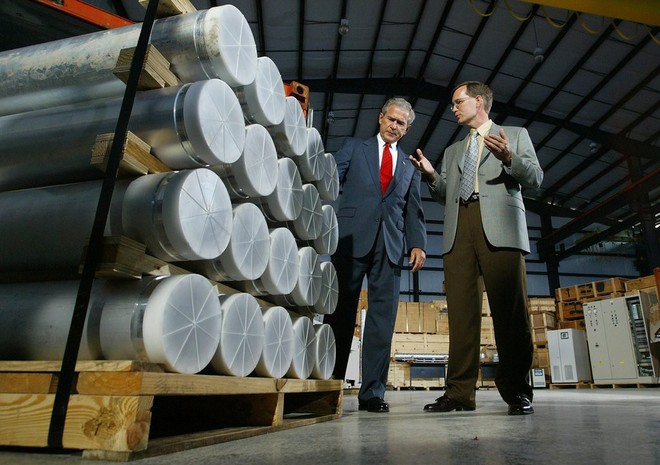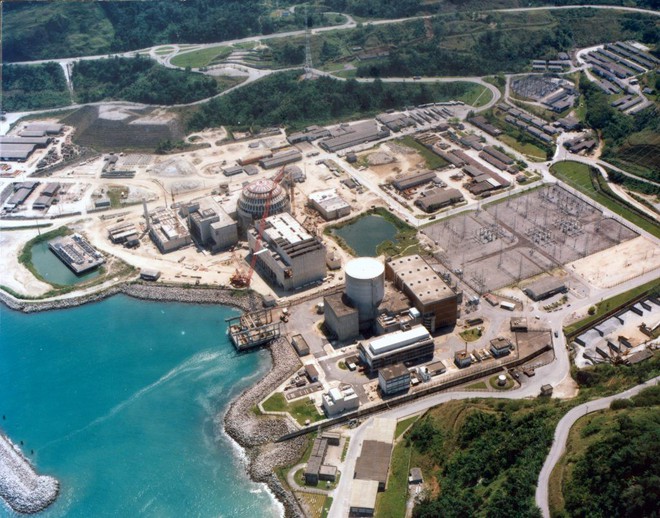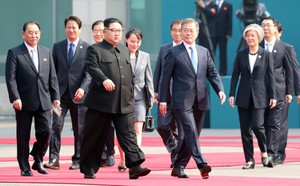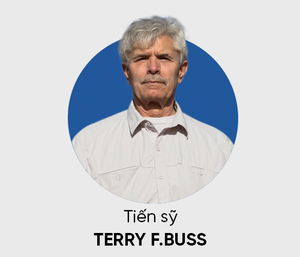People around the world are obsessed about the upcoming summit between North Korean Supreme Leader Kim Jong-un and US President Donald Trump. Will both leaders agree to remove nuclear weapons from North Korea and cease efforts to develop them in the future?
Most of the analysis thus far has focused on past failed agreements to eliminate North Korean nuclear weapons development. Since 1985, North Korea has either violated or withdrawn from agreements and treaties on nuclear weapons it has signed.
Based on the past efforts, many analysts are justifiably skeptical of the prospects.
But the world has forgotten other past efforts to eliminate the development and proliferation of nuclear weapons. These cases provide some valuable lessons for Trump and Kim.
Iran
Iran launched its nuclear program sometime in the 1950s. Since the 1970s, Iran has sparred with the West and UN over its weapon program. Iran signed the Nuclear Non-Proliferation Treaty (NNPT) but violated it. US intelligence agencies suspect that North Korea had aided Iran’s program in the past.
In 2015, Iran, then only months away from acquiring nuclear weapons, signed an Agreement with the US, European Union, and Russia to delay, but not, cease work on nuclear weapons development in exchange for economic sanctions relief, reintegration in the global economy, and return of billions of dollars confiscated by the US.
Ông Netanyahu tiết lộ số tài liệu tình báo về chương trình hạt nhân Iran.
Trump has accused President Barack Obama of signing the agreement without getting much in return. Iran was not required to cease its covert and overt support of global terrorism. Trump is now considering abrogating the Agreement.
Trump is able to do this because Obama violated US law by signing the agreement with the EU, while failing to get congressional approval which he would not have gotten, given the unpopular agreement.
Iraq
The US and a Coalition of nations invaded Iraq in 2003. The Coalition sought to eliminate the regime of President Saddam Hussein who was accused of terrorizing Iraqis and supporting terrorism elsewhere. Saddam was falsely believed to have developed a "weapons of mass destruction" capability.
Belief that Saddam was pursuing nuclear weapons was well-founded. In 1981, Israel bombed Iraq’s nuclear weapons facility at Osiraq permanently eliminating them. Nonetheless, Saddam continued to pursue his nuclear program covertly. The program is known to have started in the 1960s. In 1976, Iraq had purchased a nuclear reactor from France.
Syria
Sometime in the early 2000s, Syria, according to various intelligence sources, began developing nuclear weapons, violating the NNPT it signed in 1969. The UN Panel of Experts reported that the technology for the weapon development came from North Korea. In 2007, in response to this threat, Israel launched an air assault destroying the facility which has not been reopened.
Islamic State terrorists, occupying portions of Syria, took over the Syrian nuclear weapons facility. It is unclear what happened to the materials stored there.
Libya
In 1969, Muammar Gaddafi, ceased control of Libya in a military coup. Soon after according to intelligence services, Gaddafi tried to enlist the help of covert sources to purchase nuclear weapons, technology and materials from various sources. Libya feared Israel’s nuclear weapons arsenal.
Gaddafi boasted that he was building an "Islamic bomb." Libya had signed the NNPT in 1968, and Gaddafi ratified it in 1975, yet violated it.

In 2004, President Bush toured the Oak Ridge National Laboratory, a nuclear weapons research site in Tennessee holding some of the materials turned over by Libya as part of its agreement to give up its weapons and missile programs. CreditDoug Mills/The New York Times
Pakistan, in the 1970s, was developing its own nuclear weapons and Gaddafi convinced them to allow Libya to participate. Before Libya could join the effort, PM Bhutto was overthrown by General Zia-ul-Haq, who then ousted Libya from the program.
Gaddafi voluntarily gave up his development program in 2003, in exchange for the US removing economic sanction against his regime.
South Africa
South Africa began to develop nuclear weapons out of fear that Angola’s civil war (1975-1991) might spill over into Namibia, Botswana and South Africa. South Africa developed its nuclear weapons in partnership with Pakistani technicians (not the Pakistan Government).
Non-validated sources claim that Israel and France offered development assistance as well. In 1977, the UN banned South Africa from obtaining nuclear weapons materials from any other country.
South Africa, under the racist Apartheid Government, in 1989, gave up its nuclear weapons. In 1988, South Africa was able to sign a peace accord with Cuba and Angola which called for Cuba to leave the region in exchange by abolishing nuclear weapons.
The Apartheid Government feared that it’s nuclear weapons, under the newly-elected African National Congress in 1994, headed by Nelson Mandela, might fall into the wrong hands. Although Cuba left Angola, the civil war continued until 2002.
Ukraine
The Ukraine under the old regime housed one-third of the Soviet Bloc’s nuclear weapons. In 1991, the Ukraine voted to leave the Bloc and become an independent nation. In 1994, the Ukraine destroyed its nuclear arsenal in exchange for guarantees from the US, United Kingdom and Russia that they would protect the Ukraine sovereignty and security.
Prior to 1994, Ukraine held on to its missiles as a way to guarantee its independence. Belarus and Kazakhstan were also part of the agreement.
In 2014, Russia annexed the Crimean Peninsula from Ukraine and supported pro-Russian militia in attempting to occupy Eastern Ukraine. The US and UK did not uphold guarantees given to Ukraine.
Brazil & Argentina
Brazil, under its military junta, began developing a secret nuclear weapons program in the 1970s. In 1981, US Congressional investigators found that Brazil had exported uranium to Iraq.

Brazil’s Angra nuclear power plant. By IAEA Imagebank .
By 1987, Brazil had been able to produce weapons grade enriched uranium. In 1990, President de Mello exposed the program and permanently shut it down. In 2006, Brazil reopened its research facility.
Brazil’s nuclear weapons program was supposedly in response to a comparable program in rival Argentina. In 1992, both countries agreed to open up their facilities to jointly verify that they were not working against one another on nuclear weapons.
Lessons Learned
Nuclear Weapons Agreements: Apparently, agreements involving nuclear weapons can be meaningless. Countries intent on violating agreements do so secretly or openly. This is especially the case in military or authoritarian regimes which care little about global public opinion. Agreements only work if there is good will on all parties.
Obama’s willingness to violate US law to secure an agreement with Iran only allowed Trump to come along and possibly invalidate. Agreements need to be legitimate and legal, not just expedient.
No country enforced Ukraine’s security agreement. Libya gave up its weapons only to be invaded by Western forces, and then Islamic State terrorists. Guarantees of security need to be honored and enforced.
Sharing or Selling Technology: Even under the force of various nuclear disarmament agreements, where governments may not share technology and sell weapons, scientists in country nuclear laboratories may not be bound by such agreements.
According to the Wall Street Journal, the head of Pakistan’s nuclear program sold technology to Libya, Iran and North Korea. Analysts believe that the Pakistani government knew about this treachery.
The problem of unemployed or opportunist technicians with knowledge of how to build weapons has not been solved.
Some analysts believe that transferring technology has not been done to earn money. Pakistan apparently traded technology with North Korea. Countries have become adept at moving technology around to disguise its origins and purpose.
Denuclearization also leaves the issue of what to do with weapons grade materials. The Nuclear Threat Initiative (NTI) has a solution: It funded a bank in Kazakhstan to purchase uranium that could be used to make weapons, then "down-blended" it to be resold to civilian nuclear power plants as fuel.
NTI estimates that there is 2,000 metric tons of weapons-grade material around the globe. Much of it is not in secure facilities. This will be a major issue for North Korea.
Non-state actors seem to thrive in a "covert network" of people who benefit from transferring nuclear technology and materials. North Korea and Iran may be part of this. Global powers need to unite to shutdown these networks if there is any hope of deterring "bad actors" from developing or acquiring nuclear weapons.
Fear of Adversaries: Nearly all of the nuclear weapons development programs were undertaken out of fear of an enemy, real or perceived. Middle Eastern countries all fear Israel, its army, its US ally, and its nuclear weapons.
Russia, China and the US fear one another, so nuclear weapons represent a deterrent. Mostly, small countries like North Korea consider nuclear weapons as the great "equalizer."
Some countries can successfully work out their differences: Brazil and Argentina, and South Africa and Cuba. Agreements don’t seem to work. What does work is if countries see it in their interest to cooperate. How or why this comes about no one knows.
Of course, some countries like Iran may see nuclear weapons as a way to extort concessions from other countries. Iran sees Israel as having successfully gotten its way.
Worry Over Missiles: In the case of North Korea, the worry is over whether or not it can target missiles to the US homeland, not to mention Australia and other adversaries.
But nuclear weapons also can be reduced to the size of a suitcase. These are perfect for terrorists who don’t have missile capabilities.
Stopping the deployment of this technology is critical, yet not being considered at least openly.
It will be interesting to see how Trump and Kim approach these issues. Will Trump take the Obama approach and accept whatever Kim offers?
Or will Trump address the lessons learned above? Will Kim give in on everything or will he game the system as his father and grandfather have so expertly done?
The world anxiously awaits.

